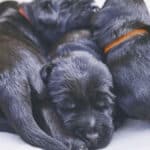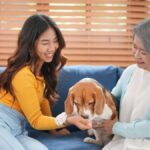The salient points of the purebred Brussels Griffon head need to be firmly imprinted in the mind of the judge, because therein lies the essence of the breed. Some of these very features are, or have been, in danger of extinction, which makes rewarding the correct type, and therefore ignoring some current trends, of utmost importance. Because the head can be a mystery for a new judge, especially a judge unfamiliar with brachycephalics, I have compiled some landmarks to look for.
Starting at the top, the ears may be cropped or natural. In either case, they should enhance the headpiece and not detract from general appearance. While there is a growing trend to refrain from cropping ears, there seems to be no complementary trend to breed correct natural ears—at least not in this country. The natural ear should be small, with the tip reaching no farther than the outer corner of the eye, and break forward evenly at or just above the topskull. They should not resemble weather satellites in search of a signal. Natural ears that are set on the corners of the head and break correctly forward do much to enhance the impression of head size and dome.
The dome of the head is also a measure of type. It is prominently rounded in the forehead area, with the frontal bones gently curving back to meet the superior orbit rims above a deep stop. The eyes are large, round, dark and face forward. The nose lays back so that a dog standing in the rain might get a snout-full. The top edge of the nose should lie on a plane with the bottom rims of the eyes—or higher. It is possible for the nose to be so dramatically placed as to be higher than the top rim of the eye. This is infinitely more desirable than a nose placed too low. Looking at the head in profile, one should see a numeral “III” leaning backwards, or for those of us who still remember cursive writing, a capital “E” leaning forward. This is easier to see on a rough-coated dog, but is a bit distorted on a smooth where the lack of beard will make the lower loop of that visual smaller than the upper arc.
Upsweep of jaw is crucial. The properly finished mouth is black-rimmed, with a prominent lower lip sitting on a wide lower jaw. A lower jaw lacking six incisors is most likely too narrow. Digging into the mouth, however, is not encouraged. Everything you need to know about the mouth can be seen with a gentle lift of the lips. Never lift the upper lip straight up in the front, as it may block the nostrils and cause the dog to panic. Rather, lift one side at a time or feel with a thumb for the required undershot alignment. The line of the closed lips viewed straight on should be a wide, shallow curve and bring to mind the gentle arch found under a graceful Parisian bridge—not the sharp ones seen in front of McDonalds. The line of the closed lips should also be scrutinized for symmetry. A lip set that appears to be off-center may be your first indication of a wry mouth. Because puppies are not born with the dramatic upsweep of jaw, the Griff face goes through some drastic changes. During this process, it is common for the lower incisors to show between closed lips. Between the ages of six months to a year, this small glimpse of teeth is forgivable, provided it is only the lower incisors. The lower canine(s) should never hook over the upper lip.
The breed is, or has been, losing some of these important head features. For several years, eye size was diminishing. This has been, to some extent, corrected by conscientious breeders. Judges play a large role in encouraging breeding trends, so please reward the large, dark eye and ignore the small or light-colored eye when possible. The pout—that prominent lower lip that gives our Griffs that “just try and make me” look—has been slipping away of late. A “Grinch” mouth is undesirable. Regardless of coat color, eye rims and lips are black.
The purebred Brussels Griffon is considered to be a head breed. I have concentrated on the features of the head because it is the essence of the breed, and often the hardest concept for the new judge to “get.” I would not like this discussion to promote head-hunting to the exclusion of all else. The selection of a sound dog of type is preferable to choosing a spectacularly dramatic headpiece that sits on a rectangular body lacking in bone.








